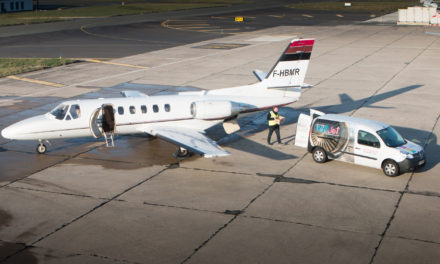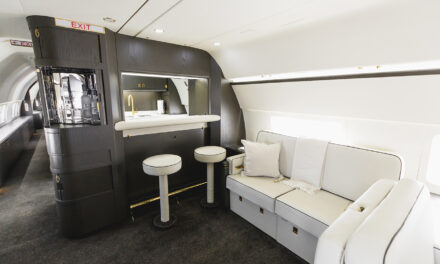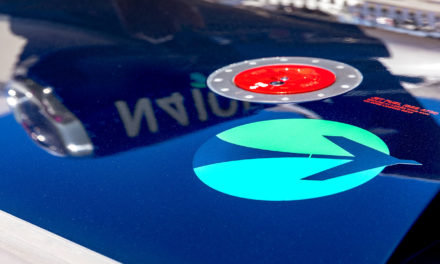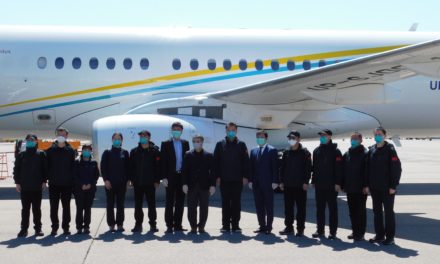Like every year since 2001, for a few days Geneva finds itself at the nerve center of the business aviation world not only for the European market but also the international scene. A not-to-be-missed event for industry professionals, the trade show held on May 22 to 24 is particularly helpful to understand the state of the sector which is struggling to emerge from the crisis.
According to the professionals interviewed following the trade show, this 2017 edition fell in line with the lackluster state of the market. Despite the feeling that there were less visitors than in the past, the industry professionals present instinctively recognized however that the professional meetings were much more relevant than in previous years. This edition counted no less than 400 exhibitors from over 40 countries around the world. The organizers of the trade show were also counting on a particularly impressive static display with no less than 59 aircraft presented including the first visits of jets such as Gulfstream’s G500, Cessna’s Citation Longitude and the Cirrus’ SF50 Vision Jet as well as turboprops with the TBM 910 and Piper M600.
TIME TO SHINE FOR MANUFACTURERS
While manufacturers once again were the talk of this event, they did not however make any major announcements, far from it. With a downturn in deliveries last year and stable traffic, even down slightly in 2016, aircraft manufacturers are still facing rough skies. The economic outlook for this industry remains relatively obscure, especially in terms of the former emerging markets such as Asia and South America. These two geographic areas considered for more than a decade as the “heart and soul” for the future of the industry, are now at the center of questions in terms of the forecasts. At the same time, all aircraft manufacturers are still struggling against the predominant role of the pre-owned aircraft sector that has flooded the market. Primary consequence, a staggering drop in prices, especially for the large cabin segment which had previously been spared. Despite these somewhat discouraging indicators, manufacturers nevertheless remain aware of a rapid change in the market and some such as Pilatus, Dassault, Gulfstream, Textron Aviation and Aerion are already looking towards the future by investing in innovative products.
TEXTRON AVIATION: FROM LONGITUDE TO DENALI
In this respect, the Wichita-based aircraft manufacturer proved to be by far the most prolific. With three programs underway (Longitude, Hemisphere and Denali), the Textron Aviation engineers, and in particular those at Cessna are certainly not idle. The aircraft manufacturer continues to raise the bar and confirms its “leadership” objective on the business aviation market by investing $200 to 300 million every year in new products such as the Longitude, an aircraft capable of transporting up to 12 passengers over a distance of 6,482 km. The twinjet program, one of whose prototypes was presented for the first time on the Ebace tarmac, now has four test aircraft that have racked up over 400 testing hours during 200 flights. With these prototypes which feature a head up display (HUD) as an option, Cessna is aiming to get the aircraft certified by the FAA (Federal Aviation Administration) by the end of the year and European certification shortly thereafter. Consequently, the aircraft manufacturer announced that Travel Service, a Czech airline, is the launch client for the aircraft in Europe. In addition to the Longitude, Textron also covered the development of its future single-engine turboprop, the Cessna Denali. The aircraft manufacturer announced that the program is moving forward on schedule and the first elements such as the cargo door of the test bench are already complete. The first tests, especially the fuel system on the integration testbed have also been begun. The manufacturer is planning for a first flight in the third quarter of 2018 and certification is expected in late 2019. The Denali is a particularly strategic program for Cessna in light of the new regulation issued last March by the European Aviation Safety Agency (EASA) for public transport with single-engine aircraft in Europe, and aims to overtake the current market leader, namely the Pilatus PC-12, the main competitor of the future aircraft. Another important announcement was the definitive end of production of the Citation Mustang. The aircraft hit the market 12 years ago and over 470 were produced. It is now replaced by the Citation M2 which has become Cessna’s standard entry model.
BOMBARDIER: REVAMPED INTERIOR
As for Bombardier, the Canadian manufacturer unveiled a new interior for its Global 5000 and 6000. The cabin focuses on a new style and layout that is radically understated yet effective. The cabin’s new key features include the integration of new seating and streamlined lateral siding. These elements upgrade the feeling of refined design. The galley has been streamlined and modernized in a contemporary style, and equipped with wood flooring and ceramic tiling. The aircraft has also been fitted with the high-speed Ka-band WiFi and a “Venue MC” cabin management system designed by Rockwell Collins. This new interior design will enable Bombardier to relaunch sales of its Global family before its Global 7000 is expected to hit the market in the second quarter of 2018. Bombardier stated that a third test aircraft (FTV3) for the Global 7000 program successfully underwent its first flight on May 11. For Michel Ouellette, Senior Vice President of the Global 7000 and Global 8000 programs: “Our test program’s development and certification schedule is on track, and the addition of our third flight test vehicle is in line with our commitment for certification in 2018 as we accumulate more flight hours”. The FTV3, dubbed the “navigator”, will be used to test the aircraft’s advanced avionics and electrical system performance.
GULFSTREAM : FIRST VISIT OF THE G500
The US aircraft manufacturer capitalized on the event to fly over a fully-fitted first production G500 from its Savannah facilities. The transatlantic flight to bring over the aircraft led to the commemoration of the 90th anniversary of Charles Lindbergh’s first flight between New York and Paris. With its twinjet on the static display set to replace the G450, Gulfstream indicated having accumulated over 2,900 flight hours during 745 test flights thanks to the program’s five prototypes. Gulfstream which is starting its FAA certification testing for the aircraft is counting on its entry into service by the end of the year. As for its big brother the G600 which will make its debut at next year’s Ebace, Gulfstream revealed that it had conducted a 13-hour endurance flight with one of the three prototypes and racked up more than 460 test hours in over 100 flights. Gulfstream expects the G600 to receive certification in 2018.
HONDAJET: IN FULL PRODUCTION
Since being certified by the FAA in 2015 and by the EASA in May 2016, there are now 57 HA-120 in service around the world. With around 60 deliveries planned by the end of the year, HondaJet is counting on the development of new markets beginning with Asia where the aircraft manufacturer stated it had kicked off aircraft sales in the South Asia region by joining forces with Thai Aerospace Services – TAS. In Europe, HondaJet stated that it had received a certain number of orders from new operators specialized in fractional ownership based on the Isle of Man. HondaJet also announced the arrival of FlyHonda as aircraft operator in Europe, following the German airline Privateairways and the training center based in Strasbourg EATIS – European Aero Training Institute. FlyHonda recently received the first private HA-120 in Europe and is awaiting another four aircraft. The company is founded on the principle of the exclusive management of HondaJets on behalf of private owners. In addition to aircraft maintenance services, FlyHonda will also offer training to owners wishing to pilot their twinjet.
ORDER FOR EMBRAER
The Brazilian aircraft manufacturer which appointed Michael Amalfitano in February as the head of its business aviation division, gave an update on its market positioning. Embraer which launched a complete range of aircraft in just over 17 years succeeded with its challenge of becoming one of the major manufacturers in the sector. Over 1,100 Embraer aircraft in all segments combined are currently in service around the world, including over 220 in the Europe and Africa region. This market which represents 19% of sales remains far behind North and South America. These two regions alone account for 44% and 26% of the Brazilian aircraft manufacturer’s deliveries. The director also reported on the two newcomers to the Legacy family, the 450 and 500 each of which have delivered over 15 and 45 aircraft since their entry into service. In addition to these two aircraft, Embraer also reported on the delivery of the first Phenom 100EV to the United States; this new version features a new engine and is fitted with a Garmin G3000 touchscreen avionics system. The trade show also provided Embraer with the opportunity to unveil Air Hamburg as the launch client of the Legacy 650E in Europe. The airline with its fleet of 11 Legacy 600/650 placed an order for three new-generation aircraft valued at $77.7 million.
FALCON 8X: TAKES THE MARKET BY STORM
Showcasing three aircraft at the static display, the French aircraft manufacturer based in Saint Cloud focused its efforts on the Falcon 8X, its current flagship. According to Eric Trappier, CEO of Dassault Aviation: “The smooth introduction of our new Falcon 8X […] suggests it will be a big success in the marketplace”. Accordingly, Dassault presented at the trade show an aircraft adopting a new configuration and fitted with a crew rest area, which is particularly useful for long-distance flights. In addition to the market response for the 8X, which counts 9 aircraft in service around the world, Dassault remains cautious in terms of sales for the entire line. Especially as the pre-owned market remains inundated, in particular over the past year. The CEO noted “however the first signs of recovery”. He also provided an update on the progress of the Falcon 5X program by indicating that “the program is on track with the revised Silvercrest development schedule, implemented to resolve the technical problems identified by Safran. We are expecting the “certifiable” engines to be ready by the end of the year in order to begin the test flight program shortly thereafter.” In line with this schedule, the aircraft manufacturer expects its first flight in 2018 and the entry into service of the twinjet in 2020. In technology news, Dassault used the trade show to present a new mobile application used to manage phone calls in flight. FalconTalk will be available in the Apple Store and Google Store and may be used on Falcons equipped with a Voice Over IP Protocole (VoIP) – a system allowing voice communication over a private network or Internet – independently from the SIM card and from a phone number allocated to the plane.
PC-24: ON THE RIGHT PATH
Pilatus is accustomed to a certain discretion regarding its programs. The PC-24 is no exception to this rule and little information was shared during Ebace. Although exhibiting a P03 prototype on the static display in line with the production standards and a fitted cabin, the aircraft manufacturer kept quiet as regards any information on the current performance of the aircraft while awaiting EASA certification which is expected by the end of the year. The first deliveries should follow shortly thereafter. Its order backlog which was closed at 84 units is expected to re-open in time for the NBAA convention in October to allow Pilatus to optimize its production line that thanks to the first orders will remain in full production capacity until at least early 2020. To meet future demand, Pilatus has already invested over $300 million in setting up new facilities primarily in Colorado, United States, as well as the historic site in Stanz, Switzerland.
AERION: NEW PARTNER
The aircraft manufacturer that has yet to produce an aircraft, Aerion, signed an agreement with GE Aviation to develop a new engine for the AS2, its future supersonic jet. The two entities signed a definitive agreement for the joint study and definition of a new engine able to meet the needs of this future trijet that will fly at Mach 1.5 over a distance of 4,750 nm (7,644 km) and 5,300 nm (8,530 km) at Mach 0.95. Aerion plans to conduct its first flight in 2020 with certification expected in 2021 and entry into service in 2023.
AIRBUS: LAUNCHES THE ACJ330 NEO
Despite 2016 being a lackluster year in terms of deliveries, the European aircraft manufacturer broadened its ACJ family by offering a new re-engined version of the A330, the A330neo. The aircraft will be presented in a configuration able to transport 25 passengers over 9,400 nm (17,400 km) or 20 flight hours, offering the possibility to directly connect Europe and Sydney. Airbus also announced the definition of a new cabin for the ACJ31neo, the “Infinito” produced in partnership with the Italian carmaker Pagani. One of the main characteristics of this new interior lies in its fully transparent ceiling offering a panoramic view of the sky throughout the cabin or able to display other images. “Art and Science can walk together hand in hand: this is the Pagani philosophy. The combination of state-of-the-art composite materials never used before in an aircraft, such as CarboTitanium, with the typical design language of Pagani Automobili, has always represented our signature,” stated Horacio Pagani, founder & Chief Designer of Pagani Automobili SpA. Curves inspired by nature form a pathway through the cabin, as well as featuring in the shell-shaped valances and walls between zones – including one between lounge and conference areas, which switches from opaque to transparent at the touch of a button. Décor is reminiscent of that gracing Pagani hypercars. Natural soft-leather carpets and a wooden floor contrasting with man-made carbonfiber in furniture and wall-frames echo the brand’s Italian artistry. The interior is comprised of a total of four areas including a lavatory and a bar. The new cabin is expected to be commercialized at the same time as the delivery of the first ACJ319neo in 2018.
A380S: SPARFELL & PARTNERS
The VIP version of the A380 has not been laid to rest. Quite the contrary, according to the directors of Sparfell & Partners, a company specialized in aircraft resale. The firm founded by Philip G. Queffelec and Christian Hatje were commissioned by the owner of four A380 previously flying the colors of Singapore Airlines to resell these aircrafts. Through its network, the company based in Geneva appears to have completed the sale of two of the four aircraft in VIP configuration to states whose nationality have evidently not been disclosed. For the sale of these four-engine aircraft, Sparfell & Partners teamed up with Andrew Winch, who envisioned a totally innovative interior design. The work on the concept, if validated may take up to 18 months in a completion center. The concept presented by the design studio and the Swiss company has come together less than two years after the cancellation of the sale of an ACJ380 on behalf of Prince Alwaleed after an agreement signed with great fanfare during the Dubai trade show in 2007. A major blow for Airbus’ ACJ branch which with the arrival of the first A380 on the pre-owned market have not yet succeeded in selling a new aircraft on the VIP segment.
SF50: READY FOR THE EUROPEAN MARKET
Cirrus Aircraft, present for the first time with its SF50 Vision Jet took advantage of the event to celebrate the European certification of its aircraft. Unveiled by the aircraft manufacturer in June 2008 the single-engine aircraft powered by a Williams FJ-33 engine was finally certified in October 2016. However, this prolonged delay allowed Cirrus to rack up over 600 orders for the aircraft including 90 machines for the European market. The Dululth-based manufacturer expects 50 units to be produced in 2017 and to increase production from 75 to 125 aircraft by 2018.
ALBERTO PINTO INTERIOR DESIGN FOR THE BBJ MAX 7
Airbus’ direct competitor also showed its prowess during the trade show.Boeing first presented the new director of its BBJ division, Greg Laxton, previously in charge of the F-15K and 737 AEWC programs. The new director who is taking over from David Longridge, will be responsible for developing Boeing’s business aviation market that nonetheless remains particularly active. Boeing revealed its backlog of six aircraft including one 747 and the delivery of two Boeing 787 and one 777. In addition to these figures, Boeing also presented the new interior for the BBJ Max 7. Designed by Alberto Pinto, the Parisian design center, it becomes the new reference for the aircraft. The new cabin with its particularly modern look was designed to demonstrate the “livable area as well as the modularity of 737 BBJ” according to the designers of the Alberto Pinto studio.
By Frédéric Vergnères
Copyright : Mathieu Douhaire / Airbus / H.Gousse / Boeing









